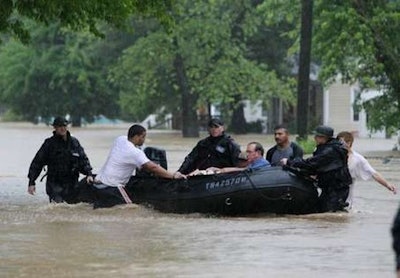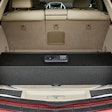 Nashville Police officers used military surplus boats to rescue residents during severe flooding in 2010. Photo courtesy of NPD.
Nashville Police officers used military surplus boats to rescue residents during severe flooding in 2010. Photo courtesy of NPD.
Last month the Defense Department cut off a very valuable resource for many of the nation's 17,000 law enforcement agencies. The Pentagon's 1033 program provides cash-strapped police and sheriff's departments with free military surplus. Agencies participating in the program have received rifles, vehicles, and medical aid equipment, both new and used that Uncle Sam doesn't want anymore.
An official statement from the Defense Logistics Agency (DLA) says the agency is halting further deliveries of military surplus until it finds out exactly what local law enforcement has been doing with all this stuff.
DLA has ordered state-appointed coordinators to perform an audit. As with just about any other accounting of any other government program, the final results of that audit will be good, bad, and ugly.
There is no doubt that much of this gear is a godsend for agencies that just can't afford to buy it new. Last year in a blog post on PoliceMag.com titled "Military Surplus Vehicles Aid the Fight," Web Editor Paul Clinton detailed some of the ways that surplus military gear has helped local law enforcement officers save lives and protect the public.
When Nashville flooded in 2010, local cops rescued 500 people from the rising waters. The nine 15-foot Zodiac inflatable boats they used for those rescues were military surplus procured from the 1033 program. Other agencies have used 1033 gear for routine police work, for SWAT operations, and to provide critical tools that they couldn't otherwise afford.
Which brings us to the bad. It's likely from the track record of the Department of Homeland Security grants during the last decade that some agencies have acquired military hardware from the 1033 program because they like "toys," not because they need the gear. Others have stockpiled military hardware such as crew-served machine guns that have very little use in civilian law enforcement.
Finally, there's the ugly. Some agencies appear to have abused the program in spectacular ways.
There have been published reports of agencies performing all sorts of sleight-of-hand with this gear. Local law enforcement officials have been accused of hoarding the military surplus for a variety of purposes never intended by the DLA. These include: personal use of the vehicles and firearms, currying favor with local businesses by bestowing them with gifts, supplying firefighting equipment to volunteer fire departments, and selling the gear at auction to augment agency budgets. In just one state, the DLA has revoked the 1033 privileges of more than 30 law enforcement agencies.
The agreement that local police and sheriff's agencies sign with Uncle Sam is basically a loan application. Gear procured through the 1033 program still technically belongs to the Department of Defense. However, after one year of use, it can be disposed of or sold. Some agencies have reportedly disposed of the equipment and vehicles in ways that violate that agreement.
Maybe some of these violations are caused by all the confusion that surrounds this program. Few federal government operations are as little understood as 1033.
The first widely believed misconception is that the free "toys" are in perfect condition and ready to use. That's usually not true. The "toys" are often broken, and the agencies receiving the gear have to spend hard currency to repair or overhaul them. The Zodiac boats that Nashville PD received from the DLA are an excellent example of how this works. Nashville PD acquired 12 of the boats, but only nine could be made operational. The remaining three were cannibalized for spare parts.
Another widely believed misconception is that this stuff is useless to the agencies receiving it. Wired.com recently ran an article in its "Danger Room" channel saying that many of the police agencies that procure this military hardware don't have the personnel qualified to use it. Considering how many law enforcement officers have served in the military that's kind of a bizarre assumption. It’s also an assumption that the Nashville example—and the experiences of hundreds of other agencies—renders false.
Sheriffs and chiefs need to clear up the misconceptions that surround the acquisition of military surplus by local law enforcement. Go to the press and explain to them how the 1033 program has helped you and how your officers are using military surplus gear to protect the public. By suspending the 1033 program, the feds have given you a hook to sell this story to editors and reporters. Strike now while the topic is hot. Get your story out to the public, or abuse, fraud, and misuse of this gear by other agencies may spell the death warrant of this critical program.
Related:
Military Surplus Vehicles Aid the Fight

















